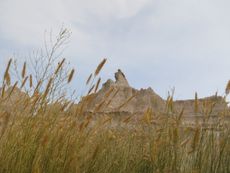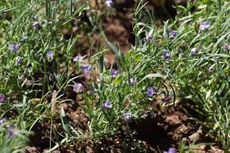Annual Ryegrass Care - Tips For Planting Annual Ryegrass


Annual ryegrass (Lolium multiflorum), also called Italian ryegrass, is a valuable cover crop. Planting annual ryegrass as a cover crop allows the dense roots to catch excess nitrogen and help break up hard soils. Ryegrass cover crops are fast growing in cool seasons. Know when to plant annual ryegrass to prevent unwanted seeding and volunteers, which can compete with primary crops.
Quick Facts about Annual Ryegrass
- Botanical name: Lolium multiflorum
- Height: 3 feet
- Spread: spreading
- Sun exposure: sun to part sun
- Soil requirements: any, well draining
- Hardiness zones: 5-9
- When to plant: early spring
What Should Annual Ryegrass Be Used For?
What is ryegrass? Annual ryegrass seed is often found in commercial cover crop mixtures. This member of the grass family is native to southern Europe, Asia, and northwest Africa. It now occurs in many temperate to tropical countries, where it has had occasion to become weedy. Another name for the grass is Italian ryegrass. The grass grows 3 feet (0.9 m) in height, with flat, hairless leaf blades rolled at the base.
Annual ryegrass can also be used to stabilize a new lawn as perennial grass establishes, and as silage or animal feed.
This versatile plant is easy to grow and promotes healthy soil and plants.
Ryegrass as a cover crop
The main use of annual ryegrass is as a cover crop. There are many benefits to planting ryegrass cover crops. It provides erosion control, increases percolation, reduces compaction, and acts as a nurse crop for fall legumes.
But it goes beyond soil improvement. The plant is also useful to reduce splashing on young plants and minimize disease in tightly planted spaces. Overseeding the grass into commercial crops works as effective weed control and increases soil fertility when hoed into the earth.
Ryegrass as turf
Annual ryegrass may be used as a turf in some situations. As an annual, cool season grass it produces a cover crop for warm season grasses. The grass is shade and cold tolerant, and abides low mowing. It is also quick to germinate and establish. It is used in combination with other species like tall fescue, Kentucky bluegrass, and perennial ryegrass. Annual ryegrass will provide cover in shady locations where warm season grasses will not persist.
Gardening tips, videos, info and more delivered right to your inbox!
Sign up for the Gardening Know How newsletter today and receive a free download of our most popular eBook "How to Grow Delicious Tomatoes."
Ryegrass as forage
Ryegrass provides 12-25% protein. This is a rich source of the nutrient for both livestock and wild animals. Deer, cattle, and sheep forage on the grass.
However, it is also a host to a fungus called Neotyphodium lolii. When animals ingest the top parts of the plant they consume a powerful alkaloid. This produces disease such as ryegrass staggers. The fungus is primarily present in late summer and early fall.
When to Plant Annual Ryegrass
Seeds in the ground will begin to emerge in March to May, but August through October is generally when to plant annual ryegrass. It can also be sown in February in well tilled soil in warm regions. It is best to sow annual ryegrass with other grasses for complete nutrition as forage, and thickest establishment in cover crop situations.
The plant will set seed more quickly if sown in fall, so care must be taken to mow before the plant blooms. To use the plant as a winter annual, seed during fall in USDA growing zone 6 or warmer. In zone 5 or colder, seed in midsummer to early fall.
If the ryegrass is used as amendment for fall crops, then seed in early spring. For a nursery crop, sow several weeks before seeding the main crop.
Ryegrass cover crops sown in fall are tilled in early in spring to enrich the soil.
Tips for Planting Annual Ryegrass
Annual ryegrass may be found in open fields, roadsides, orchards, and many other open sites. It is of some concern as an invasive plant, but is usually replaced by native plants.
Ryegrass germinates in warm or cool soils. You should till the soil and rake it free of debris and rocks. Make sure there are no clods and the soil.
Plant annual ryegrass in full to partial sun, where soil drains well. It is tolerant of almost all soil types and a range of pH. Remove weeds, rocks and other impediments to germination, which will occur in 3-5 days. Annual ryegrass can be top sown or lightly covered with soil.
Broadcast the seeds at a rate of 20 pounds (9 kg) per acre. You can also mix ryegrass seeds with legumes. Keep the area moist until germination occurs, then give it one inch of water (2.5 cm) per week.
There’s no need for annual ryegrass care in winter. The grass isn’t actively growing, and in most zones a covering of snow will cocoon and protect the plant. When temperatures warm up, the grass will begin to grow anew.
Annual Ryegrass Care in Spring
Annual ryegrass is a cool season grass. Its peak growth occurs in spring and fall. Like any grass, the plant will benefit from an application of a high nitrogen food. During spring, the grass seeds prolifically, which can lead to the plant growing in areas that are not desired.
In spring, it is best to mow consistently for best appearance, and to remove the seed heads. The ryegrass is tolerant of low mowing and heavy foot traffic. The optimum mowing height is 2-3 inches (5-7.5 cm). The plant will re-seed itself in zones above 5.
For heavily grazed areas, broadcast successive sowings spaced two weeks apart. If you accidentally let ryegrass cover crops go to seed, use a recommended specific herbicide. Your county extension service can refer you to the appropriate formulation and method of application.
Maintaining Annual Ryegrass
Outside of consistent watering and at least one fertilizing, annual ryegrass is extremely stoic. It does attract several pests such as chinch bugs, grubs, and beetles, which may require the use of an insecticide.
It has few disease issues, but rust may become a problem. There are rust resistant varieties that will reduce the chance of the fungus appearing in your crop.
Water deeply but infrequently to establish deeper roots.
Is Annual Ryegrass a Weed?
Italian ryegrass has the potential to become weedy. It colonizes quickly and thickly, and has the ability to become invasive in temperate climates. This is because of the prolific seed heads. Annual ryegrass will hybridize with perennial ryegrass. This new strain can outcompete some native grasses. In most cases, the grass is not invasive because it dies out when temperatures reach 80 F (27 C).

Bonnie Grant is a professional landscaper with a Certification in Urban Gardening. She has been gardening and writing for 15 years. A former professional chef, she has a passion for edible landscaping.
-
 Urban Composting Guide: How To Compost In The Middle Of The City
Urban Composting Guide: How To Compost In The Middle Of The CityUrban composting does not have to be daunting. You can compost in the city, and maybe even try some urban worm composting!
By Mary Ellen Ellis
-
 Shrub Diseases And Pests To Watch Out For
Shrub Diseases And Pests To Watch Out ForShrub diseases and pests can be challenging. Learn how to recognize and eradicate them before they can present a danger to your plants.
By Susan Albert
-
 Best Late Summer And Early Fall Cover Crops
Best Late Summer And Early Fall Cover CropsPlanting cover crops is a gift you can give to your garden’s soil. Read on to learn about planting cover crops in late summer.
By Bonnie L. Grant
-
 Sunn Hemp Plant Info – Learn Sunn Hemp Uses And Care
Sunn Hemp Plant Info – Learn Sunn Hemp Uses And CareSunn hemp grass is a warm weather grass. Click to learn more about Sunn hemp uses as well as helpful tips on growing Sunn hemp as a cover crop.
By Mary H. Dyer
-
 Native Cover Crops: Vegetable Cover Cropping With Native Plants
Native Cover Crops: Vegetable Cover Cropping With Native PlantsAre there any benefits to using native plants as cover crops? Click here to learn more about vegetable cover cropping with native plants.
By Laura Miller
-
 What Is Field Brome – Information About Field Brome Grass
What Is Field Brome – Information About Field Brome GrassField brome grass can be used as a cover crop to control erosion and enrich the soil. For more information, click the following article.
By Laura Miller
-
 What Is Western Wheatgrass – How To Grow Western Wheatgrass
What Is Western Wheatgrass – How To Grow Western WheatgrassWheatgrass is native to North America and graces the Southwest, Great Plains and mountainous regions of the western U.S. It has some erosion control benefits but using western wheatgrass for grazing is the primary purpose. Learn more about it here.
By Bonnie L. Grant
-
 What Is Chickling Vetch – Growing Chickling Vetch For Nitrogen Fixing
What Is Chickling Vetch – Growing Chickling Vetch For Nitrogen FixingWhat is chickling vetch? Also known by various names such as grass pea, white vetch, blue sweet pea, Indian vetch, or Indian pea, chickling vetch is a nutritious legume grown to feed livestock and humans in countries around the world. Learn more about the plant here.
By Mary H. Dyer
-
Establishing Kura Clover: Learn How To Grow Kura Clover Plants
You no doubt have heard about the four-leaf clover, but few gardeners are familiar with kura clover plants. Kura is a forage legume and if you are interested in growing kura as a groundcover or establishing kura clover for some other use, this article will help.
By Teo Spengler
-
 What Are Austrian Winter Peas: A Guide To Growing Austrian Winter Peas
What Are Austrian Winter Peas: A Guide To Growing Austrian Winter PeasWhat are Austrian winter peas? Also known as field peas, Austrian winter peas have been grown around the world for centuries, primarily as a valuable source of nutrition for humans and livestock. Click this article for info on growing Austrian winter peas.
By Mary H. Dyer